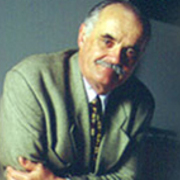
Logan Brewer
Logan Brewer had a glittering career as a project designer — responsible for major successes including the opening and closing ceremonies at the 1990 Auckland Commonwealth Games, and New Zealand pavilions at World Expos in Brisbane in 1988 and Seville in 1992. An award-winning television designer, he also worked as a producer on police drama Mortimer’s Patch and kidult series Terry and the Gunrunners.
Brewer was born in Auckland in 1945 and educated at Howick High School. After failing to get into art school, he headed for London where he found a job as a scenery artist at Laurence Olivier’s newly launched National Theatre. He also studied at St. Martin's School of Art before returning to Auckland in 1968, to become resident designer at the Mercury Theatre.
In the early 70s Brewer moved into television design, production designing for TVNZ on major dramas that included a trio of period kidult titles, Hunter’s Gold, Gather Your Dreams and Children of Fire Mountain. At the 1981 Feltex Awards, he was awarded the Stan Hosgood Award for Related Crafts for his design work.
Brewer was appointed TVNZ’s design manager, but his job disappeared in a restructuring in the early 80s. He went freelance and began to diversify beyond straight design work. Working with frequent collaborators Tom Finlayson and Dean Hill, he associate produced 1983 feature film Other Halves (based on the novel by Sue McCauley) and TV-movie The Grasscutter; he also produced the third series of rural crime drama Mortimer’s Patch for TVNZ, when it returned to screens in 1984 after being canned two years earlier.
Brewer’s next producing role came when he secured the rights to Terry and the Gunrunners — a comic written by Bob Kerr and Stephen Ballantyne about a 12-year-old skateboarder. The six-part series was made independently by company Finlayson-Hill for TVNZ, and featured performances by Billy T. James and former Goon Michael Bentine. Brewer was keen to maintain the comic book flavour of the original material, and the series used a number of techniques to achieve this. The child actors played their roles straight while performances by the adult cast were larger than life, costumes were exaggerated, and arcade-game influenced animations linked many of the sequences. There were high hopes for further series, but none eventuated.
As well as producing for film and television, Brewer began to establish a formidable reputation for himself with his work on major events. In 1981 he was the designer for the Royal Variety Concert in Auckland; and he co-ordinated design for Pope John Paul II’s visit to Auckland in 1986.
In 1988 he masterminded the New Zealand pavilion at World Expo 88 in Brisbane (working alongside former television colleagues Ian Fraser and Don Hutchings). Max Cryer described the result as a “spectacular fantasy of mists and legends, heroes and humour”. Brewer was honoured by the New Zealand Institute of Architects for his work on the pavilion — the first time the Institute had recognised anyone other than a professional architect.
Logan Brewer Production Design was formed 1988 to allow him to manage projects from conception to completion — and one of his most ambitious achievements followed, when he wrote and produced the opening and closing ceremonies for the 1990 Auckland Commonwealth Games. An MBE in recognition of his services to film and television design followed in the 1990 Queen’s Birthday Honours.
Brewer was now the designer of choice for major international projects and he created the New Zealand pavilion for the Seville World Expo in 1992. The entire building and contents were designed and manufactured in NZ, before being shipped to Spain in 100 containers and reassembled there. Other projects in the 1990s included the transformation of the old Corbans wine estate in West Auckland, the creation of the multi-media Southern Encounter aquarium complex in Christchurch's Cathedral Square and redevelopment of the Whakarewarewa thermal reserve, near Rotorua.
When TV3 won the New Zealand host broadcaster rights for the Millennium, Brewer executive produced the network’s 30 hour broadcast 2000 Today — part of a round-the-world show involving 52 countries.
In 2001 Brewer and documentary maker George Andrews conceived Te Waka - Our Great Journey, a 12 minute animated 3-D film about the first Māori voyage to New Zealand, for Auckland’s National Maritime Museum. In 2004 he produced The Whale Rider - On Stage, a stage version of the film incorporating dance, kapa haka, singing, music and theatre, written by Witi Ihimaera, with music by Hinewehi Mohi and appearances by Rawiri Paratene.
Since 2009, Brewer concentrated increasingly on sculpture.
Logan Brewer lost his fight with cancer in August 2015.
Sources include
Logan Brewer Design website. Accessed 8 August 2015
Logan Brewer Production Design website (Broken link) Accessed 30 June 2011
Max Cryer, ‘NZ Flag Flies High but Task Proved Gruelling’ - NZ Herald, 2 November 1988, Section 2, Page 3
Daniel Riordan, ‘Logan's Still Brewing Up Top Projects’ (Interview) - Sunday Star Times, 9 Mar 1997, Page 11
Peter Shaw, ‘Real Characters in Comic Book Pic’ - Onfilm, August 1985, Page 22-23